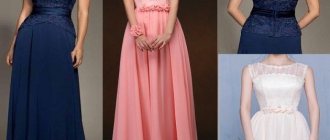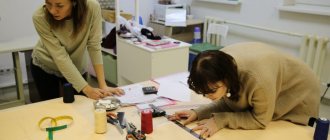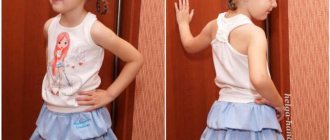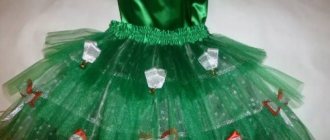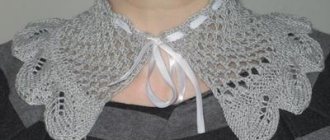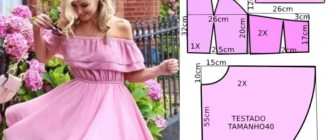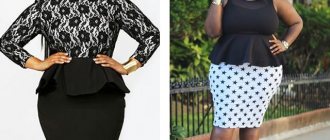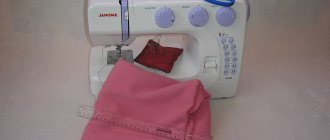A ready-made free electronic pattern for a trapeze dress for girls is designed for you to print out yourself at home. Sizes 28-36
All rights to the patterns belong to Vera Olkhovskaya.
Reproduction and resale without the consent of the copyright holder are punishable by law.
The style of the trapeze dress is very simple and sewing it will not seem difficult for beginners.
To download the dress pattern for free, click on the *.pdf file link under the heading next to the words “download attachments”.
In the same line you can see statistics of successful downloads of this pattern.
The free pattern of a dress for a girl with relief is given in full size in PDF format.
Sizes 28-36.
By downloading the pattern, you get the entire gradation of sizes.
The pictures at the bottom of the description show what the patterns look like after printing and do not reflect the actual dimensions of the pattern.
How to print a free A-line dress pattern in three clicks at home in full size
How to choose a pattern size without taking measurements and tables
The free A-line dress pattern kit includes a back, front and sleeve (Fig. 1).
As you begin to master the science of cutting and sewing, start with free children's patterns.
You can download other dress patterns for free using the links:
Ready-made free pattern for a babydoll dress
Ready-made free pattern for a children's dress with a "flashlight"
Ready-made free kimono dress pattern for girls
Ready-made free pattern for a children's dress with long sleeves
A-line dress is ideal for a woman's wardrobe: patterns and sewing instructions
A-line dress or sundress is the ideal solution for any body type! Modern models of women's dresses amaze with their diversity. But how to choose your ideal style, which will not only hide the flaws of the figure, but also emphasize its advantages? A-line dresses and sundresses are a unique solution for women of any age and body type.
What is a trapezoid style?
The name of the style speaks for itself. After all, its pattern is made in the shape of a trapezoid, the narrow part of which is directed upward. This design solution allows you to visually correct your figure, giving it feminine contours. Today you can find various variations of styles on the trapezoid theme. These can be either classic styles or casual styles. But they are all united by practicality and ease of wear. Therefore, if you don’t yet have a sundress or a-line dress in your collection, it’s time to buy one. After all, in it you will always look fashionable and modern.
A-line dresses and sundresses are also loved by pregnant women. After all, its loose cut does not restrict movement and adds elegance to the image. And this is exactly what is needed while expecting a child.
Sewing material
This fashionable style can be made from almost any fabric. However, the most popular models of world designers are made from linen, thick knitwear, cotton or staple. The choice of material depends not only on the time of year, but also on the entire image as a whole. It’s good if your collection includes sundresses and trapeze dresses, made from different fabrics and intended for different occasions. After all, once you try on this wardrobe item, you will no longer be able to refuse it.
What to combine with a fashionable a-line dress or sundress?
The choice of accessories for this model will depend not only on the situation, but also on the material from which it is made. Thus, linen sundresses and trapeze dresses go well with jewelry made of wood or natural stones. At the same time, shoes with both flat soles and wedges are welcome.
Dresses, trapeze sundresses made of thick drape or knitwear, which are usually worn during the demi-season period, are usually worn with high boots or ankle boots. For outerwear, you can give preference to a raincoat or a long fur coat. If you purchased a summer dress made of staple or thin cotton, you can safely combine it with sandals and bright jewelry. The main thing is that the entire outfit looks harmonious in color and style.
Today, lace a-line dresses, which are lined with light fabric, are very popular. By wearing this model, you will get a very gentle and romantic look. In this case, you should give preference to pastel and any light colors. After all, this season, calm colors have gained the most popularity.
A-line dress styles for slender girls
Owners of ideal proportions, it would seem, have no need to choose a trapezoid style. However, you should not immediately write off this model. After all, with the help of a flared dress you can perfectly diversify your wardrobe and impress others. A-line dress with sleeves or sleeveless for slender girls can be either short or mid-knee length. At the same time, it is worth focusing on the details. For example, choose bright high-heeled shoes that highlight slender legs. Wide-brimmed hats and massive jewelry go well with an a-line dress. But remember that only girls with a thin physique can try on such accessories.
Sew a trapeze dress for a girl with your own hands
The cut of the dress was first proposed by fashion designer Yves Saint Laurent. A characteristic feature of the outfit is that it suits all body types; it is universal. To understand how to sew such a thing for a girl yourself, you need to know the features of the construction of the drawing. It must be made with pinpoint precision, just like the model.
First you need to understand the styles of children's trapeze dresses:
- Warm for autumn;
- Festive with ¾ sleeves;
- short with pleats;
- classic black and white;
- summer made of light material.
This dress is sewn based on a finished drawing. Experienced craftswomen spend a minimum of time on this. For beginners, to sew a product quickly, you should make a pattern using a T-shirt template. In addition, in the absence of any sewing skills, you can cut a dress without a template:
- A suitable material is selected;
- Measurements are taken of the waist, hips and length of the item;
- The material is purchased based on an increase of +10 cm for allowances.
Important! If you are a beginner craftsman, then you should start with a sleeveless dress, which can later be used as a basis for sewing other things of this style.
Construction
You can quickly sew a dress of any length, both short and long. The material for sewing can be single-color or printed. A pattern for a girl is no different from an adult pattern. You just need to take into account the size of the child.
Modeling the product involves using one meter of fabric, elastic, scissors and thread. The template is easy to make yourself: calculate the bust circumference, dress length and sleeve length. Cut out a 60x73 rectangle, then draw a pattern on it:
- Cut the material into two parts - this is the base (front and back);
- Then draw out the sleeves. The armholes should match the front and back openings;
- Sew all the details in the armhole area;
- Sew the sides;
- Turn the product right side out;
- In the neck area, fold the edges several times, stitch and insert the elastic. Elastic band width - 2 cm, length - 48 cm;
- Also insert elastic into the sleeves. Fold the edges over several times, stitch in a circle and pull the elastic through.
This is interesting: Practical advice: what to do to make your jeans fit at home
The last step is to design the bottom of the dress. Fold the fabric several times and stitch.
Information. This pattern is suitable for sewing a warm A-line dress for a girl. The look can be complemented with a belt to make it look more festive.
Summer ones made of linen, cotton or staple
A summer dress made of light fabric is ideal for going to the beach. It's easy to sew it yourself. The back and front parts are cut out of cotton or linen. The side parts are assembled and stitched:
- The location of the rubber bands is marked. The product is applied to the model and elastic bands of identical size are cut;
- The pieces are sewn together and evenly distributed on the dress, then sewn on. If necessary, the product is complemented with a frill.
Linen dresses are hygroscopic, allow air to pass through well, and do not cause sweating. Clothes are easy to wash and dry quickly.
Linen embroidered products look unconventional, stylish and expensive.
A simple drawing of a linen dress includes a small number of parts and does not require complex measurements. The result is a product with wide straps.
The cotton dress includes several parts. It all depends on the position of the back and straps.
The classic version of the product is the front part, crossed straps and a skirt.
To draw a skirt, you need to measure the width of the chest and the length of the chest. The size of the straps is equal to the height of the back and half the height of the front part plus a few centimeters for the seams. The size of the straps is chosen arbitrarily.
First, the front part is attached, then the straps. A belt is sewn on the back. The bottom of the staple skirt is hemmed and finished with an overlocker. The color of the dress can be any, including the use of fabrics embroidered with ethnic patterns.
Natural cotton
To sew a cotton dress, use a piece of fabric 150 centimeters long. After that, fold it in half and take measurements of your hips and chest. Draw a half-circumference at the bottom. Then draw a line up. Sew and extend the line by one centimeter. Pull the tape into the resulting space. Sew the shoulders or secure with a brooch.
This is interesting: Stylish and cool men's T-shirts are a key element of the wardrobe
To sew a jersey dress, use a T-shirt of the appropriate size and trace it. Draw an outfit around the resulting template. Draw one part and then fold the template in half so that the halves are symmetrical. The front part should be a little longer. Any excess can be removed during the fitting process. After the pattern is drawn, you can cut it out and transfer it to the selected material.
The shoulder and side parts are sewn by hand: if the product fits perfectly, then stitch it. After this, you need to sew the armholes with the neckline area. The edges are folded inward. Buy a special tape and use it to trim the neckline.
Attention! Choose a thin material for a summer dress. If you choose a stiffer fabric, the sundress will not fit well.
From the atlas
To make a satin dress, draw a template using a T-shirt. Trace the product and leave a few centimeters for the hem. Model the hem. From the armhole on the back, make the dress flared, and design the neckline of the skirt. From the middle, draw the length of the skirt and round the bottom to the sides.
Information. For the summer period, it is best to choose loose-fitting products. The outfit can be sewn from different materials, including chiffon. Any fabric will do, but do not choose synthetics for sewing items. Remember that viscose stretches a lot, and silk dresses shrink.
Before you start working, process a small piece of material: a needle in a machine may not work. Choose your throat size arbitrarily. Don't make your neckline too deep. Also choose the length arbitrarily.
Leave some fabric for sewing on the drawstring, belt and ribbons to tighten the shoulders. Mark the location of the belt slightly below the waist. Sew the drawstring from the front part. Make two holes on it for the belt to come out. Process the hole manually.
Sew the shoulders, press the seams and stitch. You will get four drawstrings on the shoulders. Thread the ribbons through them and tighten. Hem the hem.
What is a trapeze dress, silhouette
The first appearance of the A-line on the fashion catwalk took place in 1957. Young Yves Saint Laurent, after assuming the post of chief fashion designer of the legendary house of Christian Dior, released his first collection based on the abstract artist Mondian.
The silhouette of the dress stood out from the works of other fashion designers, was immediately liked by contemporaries and soon became popular all over the world. Today, with the revival of interest in vintage items, the A-line dress is coming back into fashion.
In its first version in the 60s, the famous product had a round neckline. The dress was sleeveless, and the short skirt widened above the waist did not hinder movement.
LiveInternetLiveInternet
—Categories
- English (3)
- Aromatherapy (60)
- Beads (60)
- Charity (1)
- Felting (61)
- Great and mighty (37)
- Hair (52)
- All about LiRU (22)
- Embroidery (11)
- Knitting (25)
- Gymnastics (80)
- Homeopathy (3)
- Decoupage (42)
- Trees (18)
- Babies (245)
- Doctor Bubnovsky (5)
- House (88)
- Blanks (8)
- Health (304)
- Ideas (132)
- Icons (3)
- Interesting (199)
- Chinese medicine (17)
- Beauty (206)
- Cooking (688)
- Dough (264)
- Larisa Miller (2)
- Light legs (51)
- I love you, I can't (27)
- Massage (17)
- MK (251)
- New Year (67)
- Mosaic (11)
- Prayers (70)
- Wisdom (227)
- Traditional medicine (104)
- Rejuvenation and longevity (23)
- Oncology (25)
- Posture (35)
- Parasites (5)
- Easter (48)
- Peredelkino (28)
- Liver (25)
- Crafts (25)
- Liked (279)
- Post (2)
- Poetry (213)
- Insight (17)
- Psychology and Mind (18)
- Developing memory (6)
- Growing up (43)
- Garden and vegetable garden (64)
- My light, mirror. (1)
- Sister (9)
- Sleep (7)
- Back (7)
- SSS (15)
- Bags (20)
- Health points (113)
- Smiled (110)
- Felting lessons (32)
- Drawing lessons (49)
- Faceforming (13)
- Felt (26)
- Movies (19)
- Our daily bread (1)
- Christianity (6)
- Sewing (242)
- IVF (7)
- Elixirs of youth and longevity (26)
- Chinese medicine (1)
- It's delicious (431)
- It's stylish (74)
Necessary tools for creating a pattern
A-line dress (the pattern for beginners is based on an individual base) will not take much time to sew.
Tools needed to create a pattern:
- a simple pencil with hardness B or HB;
- paper for drawing patterns and making patterns;
- rulers 90 cm and 50 cm long;
- triangle with an angle of 90°.
Accessories for cutting and modeling patterns on fabric:
- measuring tape;
- tailor's chalk or soap;
- tailor's pins;
- tailor's scissors.
At the first stage, the shape of the figure is assessed. Depending on this, a standard design is used or an individual pattern is created for further modeling into an a-line dress. If the characteristics of the original figure are pronounced, it will be easier to make and model an individual base than to fit a ready-made one.
Dress pattern for girls
A more detailed construction of a dress for a girl is discussed in this article.We invite you to sew a summer dress for a girl 122 cm tall. The style is extremely simple and is designed for those who are taking their first steps in the field of cutting and sewing. The dress is based on a trapezoidal silhouette, widened at the bottom. The free-form pattern of a dress for a girl allows you to sew it without a zipper or fastener. The simple cut also determines the choice of fabrics: natural, mixed, cotton, preferably with a bright, printed pattern. It can be chintz, staple, madapolam, cambric, calico, satin. Please note that all these fabrics are hypoallergenic, fully meet environmental requirements, will not harm the health of your child, and their cost will not harm your budget. A fairly wide pattern fabric, without additional trimming, allows you to clearly see the fabric pattern, so feel free to choose whatever you like, since in this model the emphasis is on the interesting colors of the material. An important point at the fabric selection stage: do not forget to consult with the person who will wear your future masterpiece. The simple style is perfect for any figure. This is a universal option that can hide angular shapes or excessive fatness of a child. Both the simple cut and the cotton fabric indicate the casual nature of this model. A dress for every day: two or three of these dresses, made from fabrics of different colors, and your daughter won’t have to worry about which dress to take to the dacha, what to wear when going for a walk with her friends, or to run to the store for bread. The length of the dress pattern for a girl should be chosen individually, depending on the wishes of your little customer. You can sew a couple of dresses with different lengths, so to speak, for different situations: experiments are welcome. A simple cut will allow you to sew a children's dress pattern quickly enough: with a certain amount of diligence and patience, 2-3 hours will be enough for you. If the style of this model seems too primitive to you, it can be complicated by frills sewn along the bottom of the dress and armholes. In this case, both pattern pieces are shortened to the height of the frill. A monochromatic bias tape, matched to the tone of the main fabric used to trim the neckline and armholes, will help to visually “assemble” a pattern that is too variegated. The same trim can be used to sew the edges of the frill if you choose the second, more complex version of the dress.
Measurements used:
- Height: 122 cm.
- Bust: 62cm
- Waist: 58cm
- Hip: 68 cm
- Back length: 29 cm
- Neck circumference: 29.5 cm
- Shelf - 1 piece with fold
- Back - 1 piece with fold
The dress consists of two folded parts: a front and a back. Make a paper pattern, lay the pieces out on the fabric and cut them out, taking into account seam and hem allowances. Stitch the shoulder sections. Fold the bias tapes for finishing the neckline and armholes in half lengthwise and iron them. Stitch the neckline and armholes cleanly using appropriate, double-folded bias tape and stitch to the edge and at a distance of 0.75 cm. Stitch the side edges. Make it a habit to iron each seam immediately after you stitch it. Fold the allowances of the bottom edge of the dress and stitch them to the edge and at a distance of 0.75 cm. Iron everything thoroughly. Try on the dress more often, especially at the initial stage - this will allow you to adjust the product in a timely manner, perfectly fitting it to your figure.
How to take measurements for a dress correctly
Based on the measurements, they build an individual base and make changes to the finished pattern. All measurements are taken on the body, with a minimum of things worn. It is optimal that only underwear is worn on the body.
At the stage of taking measurements, the woman is wearing the bra with which she is supposed to wear the future dress, and fittings will be carried out with it. Shoes with the right heel height will give your figure the correct pelvic position and help you choose the appropriate length for the product. A thin belt should be tied around the waist; this technique allows you to accurately measure the torso.
To build and model a trapeze dress, you will need the following measurements:
| Name | Sequence of measurements |
| Half torso at chest level | The measuring tape runs around the highest points of the chest. On the back the tape is located horizontally. |
| Half waist | The tape is on the narrow part of the torso, parallel to the floor. |
| Half hip circumference | The measuring tape runs strictly horizontally along the highest points of the buttocks. |
| Position of the highest point of the chest | The distance is measured from the protruding point of the chest to the intersection of the line of the base of the neck and the shoulder seam. |
| Front length to waist | Measured from the point of intersection of the line of the base of the neck and the shoulder seam to the waist level. The tape passes through the highest point of the chest. |
| Dress length to back waist | The distance is measured from the point of intersection of the line of the base of the neck and the shoulder seam to the waist level. The tape passes through the protruding point of the shoulder blade. |
| Width of the chest at its narrowest part | The measurement is taken in a straight line, between the front corners of the folds of the armpits |
| Width of wide back | A measuring tape connects the back corners of the armpit folds |
| Shoulder width | between the extreme points, from the right shoulder to the left. |
| Shoulder circumference | The tape is located along the widest part of the arm. |
| Sleeve length (if available) | The distance from the protruding point of the shoulder to the wrist or desired. |
| Dress length | The tape is located from the highest point of the shoulder seam to the level of the desired length of the product. The tailor's tape passes through the highest point of the chest. |
Some measurements are used only for the selected product style:
- pocket entry height;
- level of yoke on the shelf;
- level of yoke on the back;
- underbust line;
- wrist circumference (for long sleeves);
- elbow circumference (for long, fitted sleeves).
Having a similar model in your wardrobe will simplify the task of determining the length of the dress and the location of the shaped lines. Measurements are taken from the finished product and transferred to the pattern drawing.
This is interesting: Pattern Plush hat with ears and tassels (size 86/92, 98/104, 110/116)
Step-by-step construction of a pattern
The trapeze dress (a pattern for beginners is presented later in the article) is built on the basis of an individual dress base with a set-in sleeve. For a figure close to standard, a ready-made pattern is used. Correctly taken measurements will help determine the size and location of changes.
Construction based on the finished pattern is carried out in several stages:
- The main lines of the base pattern are transferred to the prepared paper. From the basic base, the new pattern does not use darts at the waistline, they do not need to be transferred to the new drawing.
- The chest dart is moved to the armhole.
- Along the bottom line there is an expansion of the shelf and back. The expansion is laid according to the model from 7 to 15 cm.
- A new side seam line is drawn. At the upper point of intersection with the armhole, it coincides with the base, then gradually expands - slightly to the waist line and strongly to the bottom line.
- The construction of a set-in sleeve for an A-line dress has no special features; the base pattern is used without changes.
- The position of the pockets is marked on the shelf, the details of the pockets (valve, patch pocket) are drawn on the shelf, then transferred to a separate sheet.
Large symmetrical parts of the back and shelf are cut out in half, and a fold line is marked in the center. Small parts are cut out entirely. The A-line dress looks good with raglan sleeves. The armhole line directed towards the neckline emphasizes the model's extended silhouette.
The easiest way to model raglan is on a proven basis with a set-in sleeve:
- On the pattern of a single-seam sleeve, a line is drawn connecting the point of the height of the sleeve cap and the middle of the line of the bottom of the sleeve.
A-line dress: pattern with raglan
- The sleeve is combined with the armhole at the point of the front roll (in the narrow part of the armhole and the corresponding point on the sleeve).
- The front roll point is connected to the neckline, the line is drawn at a similar angle to the side line.
- To construct the back half of the sleeve, the steps are repeated.
Raglan is the easiest to process. To sew it in, you do not need to shape the fit of the edging relative to the armhole. First, all the details of the dress are assembled, the neckline and fastener are processed, then the side sections are sewn down and the bottom of the product is folded.
We sew for dolls
Creating an outfit for a doll is easy. How to do it?
- To model the upper half, measure the circumference of the chest, waist and hips;
- Calculate the length of the bodice. Transfer your calculations to paper;
- Draw a line and mark three points;
- Set aside ¼ of the circle calculations from these points;
- Place the bodice at the desired height.
This is interesting: Schemes, patterns and their descriptions: how to knit a sweater
The pattern should make the front part of the dress. You need to make darts under the bust, minimizing the curvature of the side seam.
Important! If clothes are made for a Barbie doll, then you need to increase the waist size by 1.5 centimeters.
You can sew clothes for dolls without trying them on using a ready-made pattern. Using the template you can create different dresses.
Take the base and attach it to the paper, trace and cut out. Transfer the finished drawing to the material, add a few centimeters for allowances. Cut out the parts, sew them and try them on the doll. You may need to modify the darts in the waist and bust area. Mark them on the template to make your work easier in the future.
When the bodice and skirt are sewn, you can move on to combining them into a dress. Carefully hem the pieces, trim the excess, then sweep. Place a satin ribbon over the seam.

